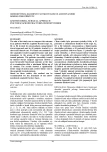EFFECT OF ISOVOLEMIC HAEMODILUTION IN NONANEMIC PATIENTS UNDERGOING TOTAL HIP REPLACEMENT
Authors:
Bořek Kučera; Radek Hart; Václav Štipčák
Authors‘ workplace:
Department of Ortopaedics and Traumatology General Hospital Znojmo
; Ortopedicko-traumatologické oddělení nemocnice Znojmo
Published in:
Úraz chir. 14., 2006, č.4
Overview
Purpose of the study:
The aim of this prospective pilot study was to evaluate the efect of isovolemic hemodilution in nonanemic patients undergoing total hip arthroplasty.
Methods:
In 2004 and 2005, in 44 consecutive nonanemic patients who underwent elective, unilateral, primary total hip arthroplasty for primary osteoarthritis isovolemic haemodilution was performed at authors´ institution. The mean intraoperative blood loss was 410 ml.
Results:
The mean blood volume returned to the patient was 389 ml. No complications were observed during the isovolemic haemodilution. Postoperative blood transfusion was required only in 13 cases.
Conclusions:
Our study suggests that the isovolemic haemodilution might help to minimize different risks of blood transfusions and may reduce the cost for blood management for patients treated with large hip replacement.
Key words:
total hip replacement, isovolemic haemodilution.
Sources
1. Amaranath, L., Cascorbl, H.F., SinghAmaranath, A.V. et al. Relation of anesthesia to total hip replacement and control of operative blood loss. Anesth Analg. 1975, 54, 641–648.
2. Bierbaum, B.E., Callaghan, J.J., Galante, J.O. et al. An analysis of blood management in patients having a total hip or knee arthroplasty. J Bone Joint Surg. 1999, 81A, 2–10.
3. Billote, D.B., Glisson, S.N., Green, D. et al. A prospective, randomized study of preoperative autologous donation for hip replacement surgery. J Bone Joint Surg. 2002, 84A, 1299–1304.
4. Larsen, R. et al. Anestézie. Praha: Grada Publishing, s.r.o. 1998. 362 s.
5. Lemos, M.J., Healy, W.L. Blood transfusion in orthopaedic operations. J Bone Joint Surg. 1996, 78A, 1260–1270.
6. Salido, J.A., Marin, L.A., Gomez, L.A. et al. Preoperative hemoglobin levels and the need for transfusion after prosthetic hip and knee surgery: analysis of predictive factors. J Bone Joint Surg. 2002, 84A, 216–220.
7. Woolson, S.T., Watt, J.M. Use of autologous blood in total hip replacement. A comparative program. J Bone Joint Surg. 1991, 73A, 76–80.
Labels
Surgery Traumatology Trauma surgeryArticle was published in
Trauma Surgery

2006 Issue 4
- Metamizole vs. Tramadol in Postoperative Analgesia
- Metamizole at a Glance and in Practice – Effective Non-Opioid Analgesic for All Ages
- Possibilities of Using Metamizole in the Treatment of Acute Primary Headaches
- Current Insights into the Antispasmodic and Analgesic Effects of Metamizole on the Gastrointestinal Tract
- Spasmolytic Effect of Metamizole
Most read in this issue
- LIMITED DORSAL SURGICAL APPROACH FOR THE SCAPHOID FRACTURES OSTEOSYNTHESIS
- The Arthroscopic Reconstruction of the Anterior Cruciate Ligament Using Semitendinosus Tendon with Endobutton Position – Evaluation 5 Years after the Surgery
- EFFECT OF ISOVOLEMIC HAEMODILUTION IN NONANEMIC PATIENTS UNDERGOING TOTAL HIP REPLACEMENT
- Penetrating brain injury caused by nail of pneumatic gun
